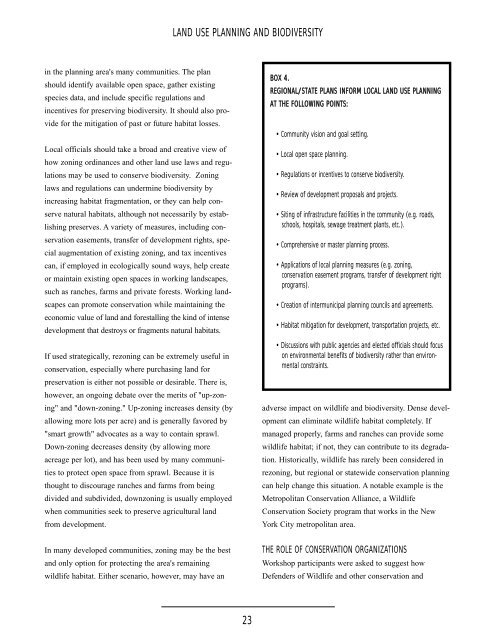Integrating Land Use Planning and Biodiversity - Defenders of Wildlife
Integrating Land Use Planning and Biodiversity - Defenders of Wildlife
Integrating Land Use Planning and Biodiversity - Defenders of Wildlife
You also want an ePaper? Increase the reach of your titles
YUMPU automatically turns print PDFs into web optimized ePapers that Google loves.
LAND USE PLANNING AND BIODIVERSITY<br />
in the planning area's many communities. The plan<br />
should identify available open space, gather existing<br />
species data, <strong>and</strong> include specific regulations <strong>and</strong><br />
incentives for preserving biodiversity. It should also provide<br />
for the mitigation <strong>of</strong> past or future habitat losses.<br />
Local <strong>of</strong>ficials should take a broad <strong>and</strong> creative view <strong>of</strong><br />
how zoning ordinances <strong>and</strong> other l<strong>and</strong> use laws <strong>and</strong> regulations<br />
may be used to conserve biodiversity. Zoning<br />
laws <strong>and</strong> regulations can undermine biodiversity by<br />
increasing habitat fragmentation, or they can help conserve<br />
natural habitats, although not necessarily by establishing<br />
preserves. A variety <strong>of</strong> measures, including conservation<br />
easements, transfer <strong>of</strong> development rights, special<br />
augmentation <strong>of</strong> existing zoning, <strong>and</strong> tax incentives<br />
can, if employed in ecologically sound ways, help create<br />
or maintain existing open spaces in working l<strong>and</strong>scapes,<br />
such as ranches, farms <strong>and</strong> private forests. Working l<strong>and</strong>scapes<br />
can promote conservation while maintaining the<br />
economic value <strong>of</strong> l<strong>and</strong> <strong>and</strong> forestalling the kind <strong>of</strong> intense<br />
development that destroys or fragments natural habitats.<br />
If used strategically, rezoning can be extremely useful in<br />
conservation, especially where purchasing l<strong>and</strong> for<br />
preservation is either not possible or desirable. There is,<br />
however, an ongoing debate over the merits <strong>of</strong> "up-zoning"<br />
<strong>and</strong> "down-zoning." Up-zoning increases density (by<br />
allowing more lots per acre) <strong>and</strong> is generally favored by<br />
"smart growth" advocates as a way to contain sprawl.<br />
Down-zoning decreases density (by allowing more<br />
acreage per lot), <strong>and</strong> has been used by many communities<br />
to protect open space from sprawl. Because it is<br />
thought to discourage ranches <strong>and</strong> farms from being<br />
divided <strong>and</strong> subdivided, downzoning is usually employed<br />
when communities seek to preserve agricultural l<strong>and</strong><br />
from development.<br />
BOX 4.<br />
REGIONAL/STATE PLANS INFORM LOCAL LAND USE PLANNING<br />
AT THE FOLLOWING POINTS:<br />
• Community vision <strong>and</strong> goal setting.<br />
• Local open space planning.<br />
• Regulations or incentives to conserve biodiversity.<br />
• Review <strong>of</strong> development proposals <strong>and</strong> projects.<br />
• Siting <strong>of</strong> infrastructure facilities in the community (e.g. roads,<br />
schools, hospitals, sewage treatment plants, etc.).<br />
• Comprehensive or master planning process.<br />
• Applications <strong>of</strong> local planning measures (e.g. zoning,<br />
conservation easement programs, transfer <strong>of</strong> development right<br />
programs).<br />
• Creation <strong>of</strong> intermunicipal planning councils <strong>and</strong> agreements.<br />
• Habitat mitigation for development, transportation projects, etc.<br />
• Discussions with public agencies <strong>and</strong> elected <strong>of</strong>ficials should focus<br />
on environmental benefits <strong>of</strong> biodiversity rather than environmental<br />
constraints.<br />
adverse impact on wildlife <strong>and</strong> biodiversity. Dense development<br />
can eliminate wildlife habitat completely. If<br />
managed properly, farms <strong>and</strong> ranches can provide some<br />
wildlife habitat; if not, they can contribute to its degradation.<br />
Historically, wildlife has rarely been considered in<br />
rezoning, but regional or statewide conservation planning<br />
can help change this situation. A notable example is the<br />
Metropolitan Conservation Alliance, a <strong>Wildlife</strong><br />
Conservation Society program that works in the New<br />
York City metropolitan area.<br />
In many developed communities, zoning may be the best<br />
<strong>and</strong> only option for protecting the area's remaining<br />
wildlife habitat. Either scenario, however, may have an<br />
THE ROLE OF CONSERVATION ORGANIZATIONS<br />
Workshop participants were asked to suggest how<br />
<strong>Defenders</strong> <strong>of</strong> <strong>Wildlife</strong> <strong>and</strong> other conservation <strong>and</strong><br />
23
















![[PDF] Community Development Toolkit - CommDev](https://img.yumpu.com/48616495/1/184x260/pdf-community-development-toolkit-commdev.jpg?quality=85)
